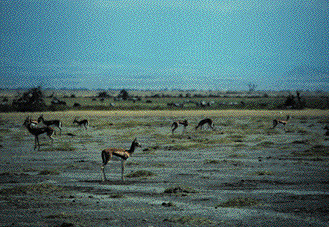
Thompson's gazelle, Gazella thompsonii, Amboseli, Kenya |
Exploring the foraging ecology and the dynamics of group formation by wild Thompson's Gazelles in Kenya, East Africa
|

Thompson's gazelle, Gazella thompsonii, Amboseli, Kenya |
Exploring the foraging ecology and the dynamics of group formation by wild Thompson's Gazelles in Kenya, East Africa
|
Thompson's gazelles typically occur in herds of varying size and composition, yet they seldom interact socially with their neighbors. Anti-predation arguments seem insufficient to explain natural levels of variation in their gregarious habits, prompting a study of whether they adhere to "ideal free" models of settlement onto resources. In 1988 I accepted a post-doctoral position at the University of California, San Diego to work with Drs Jack Bradbury and Sandy Vehrencamp (both now retired). My wife and I then spent most of the following three years living in a tent on the East African savanna; mapping gazelles and their food on a variety of spatial and temporal scales (Clifton & Clifton 1991; Clifton et al. 1994).The magnitude and complexity of these data eventually required the development of new software programs that could simultaneously generate maps of resource availability and gazelle dispersion while incorporating relevant spatial statistics. When combined with data on food intake, our results revealed that gazelles conform to ideal free predictions only during periods of intermediate resource availability (e.g. transitions from the wet to the dry season). When resources were scarce (dry season), passive interference among gazelles reduced food intake and increased step rates in the poorest areas; gazelles became over-aggregated in rich food patches. In contrast, when resources became super-abundant (wet season), gazelles dispersed randomly on the sward, irrespective of food quality. Constraints on ruminant feeding largely determine basic gazelle foraging "decisions" in patchy environments (e.g. search, step, or bite; turn or go straight; Bradbury et al. 1996), highlighting the need to include the relationship between such constraints and underlying food availability when considering why these grazers disperse as they do.
Relevant Publications:
Bradbury, J.W., Vehrencamp, S.L., Clifton, K.E, & Clifton, L.M. 1996. The relationship between bite rate and local forage abundance in wild Thompson's gazelles. Ecology 77: 2237-2255.
Clifton, K.E., Bradbury, J.W. & Vehrencamp, S.L. 1994. The fine grain mapping of grassland protein densities. Grass and Forage Sci. 49:1-8.
Clifton, K.E. & Clifton, L.M. 1991. A field method for the determination of total nitrogen in plant tissue. Commun. in Soil Sci. Plant. Anal. 22:851-860.